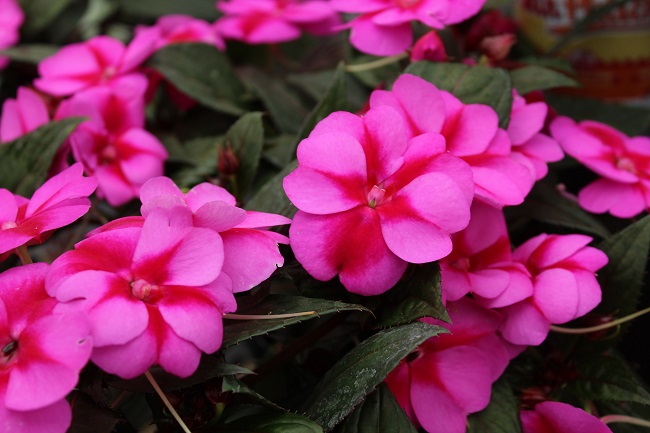
Impatiens are native to Eastern Africa. This species is among those groups of plants whose genus name is so popular that it became a familiar name. Back in the 19th and 20th centuries, human beings transported the orange jewelweed (Impatiens capensis), which originated in North America, to England, France, Sweden, Poland, the Netherlands, and Finland. These were later propagated to other areas like Central and Northern European countries as well. This is the reason why, for example, the Impatiens were not found in Germany until late in 1996.
The man who is responsible for the popularity of Impatiens is Claude Hope. The plant was first collected in 1865 in Zanzibar in Central Africa. Originally, the plant was named I. sultana as an honor given to the Sultan of Zanzibar, which was later revised and changed to I. walleriana, given in tribute to Horace.
Impatiens flowers are bright and cheerful annuals that can light up any dark and shady part of your yard. The most widely grown plants are shorter than the ones found in the wild and don’t grow more than a one foot tall. They are shade loving plants and do best in moist, fertile soil. Water regularly to keep soil moist, but not soggy. Impatiens tend to wilt quickly if allowed to dry out. Impatiens planted under a tree will require more watering and fertilizer than those planted by themselves.
While many of the plants are treated as annuals, some varieties will self-seed and produce new plants the following year. These colorful, long-lasting flowers can be grown in flowerpots, hanging baskets, garden beds, and window boxes. They can be planted indoors and outdoors.
Growing impatiens is quite easy, but there are a few things to know about impatiens care.
How to Care for Impatiens
Impatiens plants are normally purchased as well-rooted plants from the garden center. When you bring your annuals home from the store, make sure that you keep them well watered until you get them in the ground. They are very sensitive to lack of water and will wilt quickly if they lack water.
You can use impatiens flowers as bedding plants, border plants, or in containers. They enjoy moist but well-draining soil and partial to deep shade.
Once all danger of frost has passed, you can plant your impatiens out in your garden. To plant them, gently squeeze the container to loosen the soil. Invert the pot in your hand and the impatiens plant should fall out easily. Place the impatiens plant in a hole that is at least as deep and wide as the rootball. The plant should sit at the same level in the ground as it did in the pot. Gently backfill the hole and water thoroughly. You can plant impatiens flowers quite close to one another, 2 to 4 inches apart if you like. The closer they are planted together, the faster the plants will grow together to form a bank of beautiful color.
Once your impatiens are in the ground, they will need at least 2 inches of water a week if planted in the ground. If the temperatures rise above 85 degrees F., they will need at least 4 inches per week. If the area where they are planted does not receive that much rainfall, you will need to water them yourself. Impatiens plants in containers will need watering daily, and watering twice a day when temperatures rise above 85 degrees F. Impatiens flowers do best if fertilized regularly. Use water soluble fertilizer every two weeks through spring and summer. You can also use slow-release fertilizer at the beginning of the spring season and once more halfway through summer. Impatiens do not need to be deadheaded. They self-clean their spent blooms and will bloom profusely all season long.
Fun Facts About Impatiens
Impatiens is not a plant for the touchy-feely types. The nickname, touch-me-not, refers to the fact that when the mature seed capsules are touched ever so lightly, they will “explode” and send seeds flying as far as 20 feet from the plant.
Impatiens can also be called “Busy Lizzy” because the plant is a prolific bloomer, producing bright, colorful flowers from early summer to fall. Flowers come in assorted solid colors including, red, orange, pink, white and violet; they can be single, semi-double and double blooms.
It is a genus of about 850-1,000 species of flowering plants native to Africa. In the wild, they can be found in roadside ditches and riverbanks.
The name impatiens comes means impatient in Latin, because the seed pods can be so impatient to open up.
During its life, some of the impatiens species undergoes a sex change. When the flower first opens, it is male; when the pollen shell sheds, the flower becomes female.
Jewelweed, a type of impatiens, contains anti-inflammatory and fungicide properties, and is often used as a herbal remedy for bee stings, insects bites and skin rashes.
Impatiens are considered toxic and can cause vomiting and diarrhea.
Some varieties of impatiens can be used as a dye for Henna and hair coloring.
In ancient China, impatiens petals were mixed with roses, orchids and alum to make nail polish
Impatiens carry a symbolic meaning of motherly love. However, in some cultures, much as the name suggests, Impatiens do represent impatience.
Related Articles & Free Email Newsletter Sign Up
Flowering Maple is a Versatile Landscape or Houseplant




Comment here